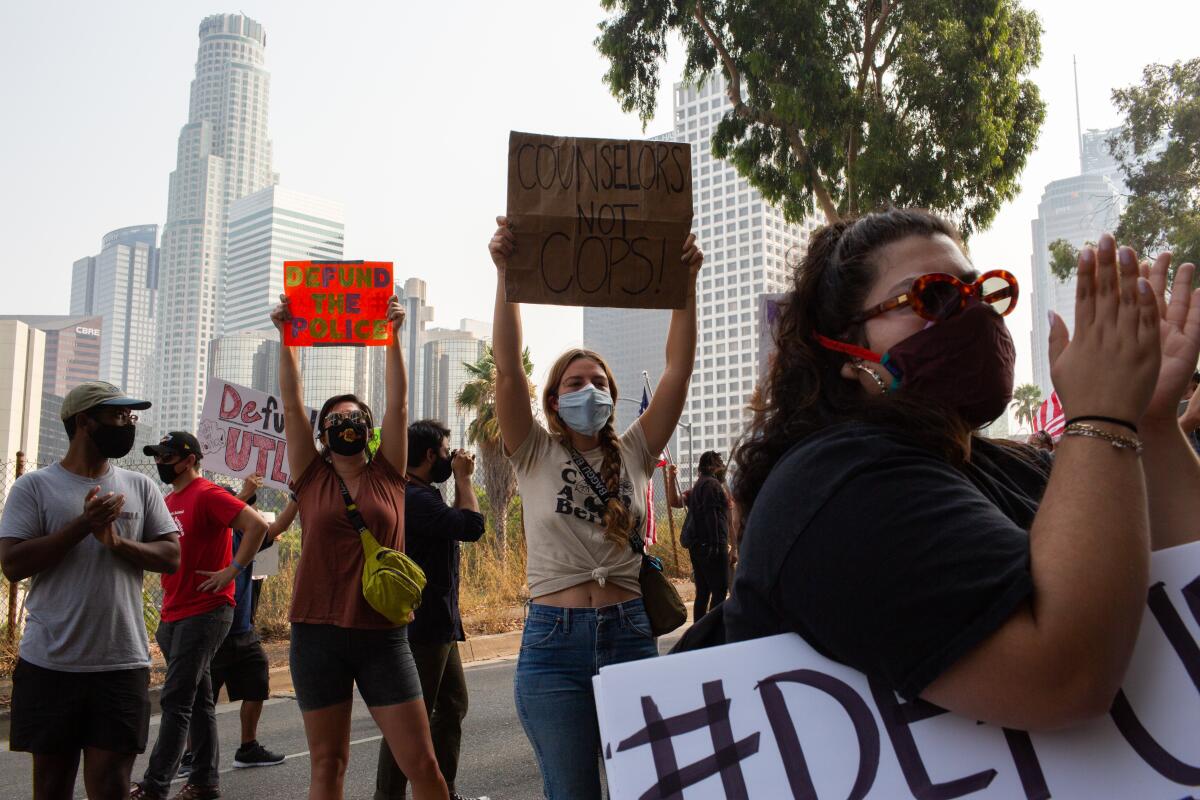Are the school districts that ‘defunded the police’ already regretting it?

- Share via
The idea of “abolishing” or “defunding” the police has always struck me as risky, to say the least, and not very well thought through. It has the potential to cause at least as many problems as it solves.
So when some school districts actually decided give it a try, I worried they might come to regret it sooner rather than later.
Which is exactly what happened in Pomona.
To recap: In July, after a long campaign by community activists, the Pomona Unified School District ended its contract with the Pomona Police Department, saying it would do away with on-campus police patrols and rely instead on “proctors” trained to deescalate tense situations.
In China, Israel and Russia — just as in the U.S. — there are battles over how to remember the past.
Guess what? Four months later, after a shooting near Pomona High School left a 12-year-old injured from glass and debris, the school board reversed course and voted to renew the contract. Last week, the Pomona City Council ratified that decision.
And Pomona is not alone. Fremont, in Northern California, also reversed its decision to defund school police. Several other cities among the dozens that eliminated their school police have also considered reinstating them.
So does this suggest that defunding school police was a crazy idea from the start and we can soon go back to the way things were?
Well, sort of. But sort of not.
On the one hand, of course we need police — in schools as elsewhere. Eliminating them, especially without significant study and clear alternative plans, is reckless.
There are, after all, millions of incidents of drug use, theft, fights, gang activity, sexual assault and weapons possession each year in public schools around the country. Not to mention the infrequent but horrifying school shootings that plague the country. Police are not the root of the problem, and they need to be part of the solution.
Opinion Columnist
Nicholas Goldberg
Nicholas Goldberg served 11 years as editor of the editorial page and is a former editor of the Op-Ed page and Sunday Opinion section.
But we shouldn’t revert to business as usual.
No reasonable person should want to see one more cop than necessary in a school. Police presence sends a message to students that they are suspected criminals, and need to be surveilled, controlled and disciplined.
Furthermore, by many accounts, school police have a tendency to criminalize nonviolent, run-of-the mill misbehavior.
“When I taught in Watts, I saw cops who were great when there was a gun threat,” said Nick Melvoin, a member of the L.A. Unified school board. “But I also saw cops ticketing kids who were late to class, or responding when they talked back to teachers. These are things that shouldn’t be handled by armed police officers.”
There have been repeated allegations of excessive force by school police. In August, for instance, a deputy at Lancaster High School was seen on video slamming a student to the ground. In September, a Long Beach school safety officer shot and killed an 18-year-old after a fight near school.
What’s more, repeated studies around the country have shown disparate treatment of students of color by school police, including disproportionate arrests for Black and Latino kids.
Readers question why an 18-year-old fleeing a fight was mortally wounded even though she appeared to pose no serious threat to the officer.
So reform is in order.
Here in Los Angeles, LAUSD — which serves more than 600,000 students — tried to find the middle ground. The school board didn’t eliminate the police, but it did vote in June 2020 to reduce the funding for the Los Angeles School Police Department by one-third, or about $25 million. That meant cutting about 133 positions, including about 70 sworn officers.
The board said it would divert the money to improving schools with large concentrations of Black students.
That sounds good in theory, but it was worrisome too — because the board acted precipitously under pressure from students and activists in the wake of George Floyd’s killing, without waiting for recommendations from a task force on the issue already convened by then-Supt. Austin Beutner.
Why not wait for the experts to report back? Was the problem really the number of cops, or something else? Why cut 70 officers rather than 10 or 200? (After the cuts, the task force took such questions off the table and focused, instead, on how to move forward.)
Now, what’s done is done. It’s too soon to judge the effect because school has been mostly virtual, but with full in-person school back as of August, some principals are already saying they want their police restored.
Student activists in Los Angeles have changed the landscape for school policing in the Los Angeles Unified School District and they vow to move on to bigger issues.
The district, to its credit, is trying to encourage less dependency on police. Alfonzo Webb, L.A. Unified’s director of operations, told me that the diverted $25 million (and more) is being used to, among other things, add psychiatric social workers, restorative justice counselors and staff trained in “trauma-informed practices.” Police are no longer based routinely in high school buildings and only come in when called.
The district in recent years wisely banned the use of pepper spray and certain chokeholds by school officers. It did away with random searches of students for weapons, and stopped the horrifying practice of accepting surplus military equipment from the Pentagon, including grenade launchers and assault rifles.
Maybe it’s now time to take away guns from the school police. (For the record, no L.A. School Police officer has ever fired a gun on campus since the force was created in 1984, Beutner said last year.)
Continued training in conflict deescalation is important. And training on systemic racism and implicit bias.
Serious incidents in schools will continue to require a law enforcement response. But let’s hope L.A. Unified closely monitors the cutbacks so it can authorize more police officers where necessary and find other, more appropriate solutions where they are not.
More to Read
A cure for the common opinion
Get thought-provoking perspectives with our weekly newsletter.
You may occasionally receive promotional content from the Los Angeles Times.














